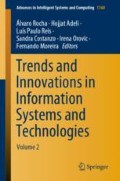Abstract
In this paper, we analyze public transport passenger movement data to detect typical patterns. The initial data consists of smart card transactions made upon entering public transport, collected over the course of two weeks in Saint Petersburg, a city with a population of 5 million. As a result of the study, we detected 5 classes of typical passenger movement between home and work, with the scale of one day. Each class, in turn, was clusterized in accordance with the temporal habits of passengers. Heat maps were used to demonstrate clusterization results. The results obtained in the paper can be used to optimize the transport network of the city being studied, and the approach itself, based on clusterization algorithms and using heat maps to visualize the results, can be applied to analyze public transport passenger movement in other cities.
Access this chapter
Tax calculation will be finalised at checkout
Purchases are for personal use only
References
Agard, B., Morency, C., Trepanier, M.: Analysing the variability of transit users behaviour with smart card data. In: IEEE Conference on Intelligent Transportation Systems, Proceedings, ITSC, pp. 44–49 (2006)
Agard, B., Morency, C., Trepanier, M.: Mining public transport user behavior from smart card data. IFAC Proc. Vol. 39, 399–404 (2006)
Aslam, N., Cheng, T., Cheshire, J.: A high-precision heuristic model to detect home and work locations from smart card data. Geo-spatial Inf. Sci. 22(11), 1–11 (2018)
Bagchi, M., White, P.R.: The potential of public transport smart card data. Transp. Policy 12, 464–474 (2005)
Bagchi, M., White, P.R.: What role for smart-card data from bus systems? Municipal Eng. 157, 39–47 (2004)
Barry, J., et al.: Origin and destination estimation in New York city with automated fare system data. Transp. Res. Rec. 1817, 183–187 (2002)
Briand, A.-S., et al.: A mixture model clustering approach for temporal passenger pattern characterization in public transport. Int. J. Data Sci. Anal. 1, 37–50 (2015)
Devillaine, F., Munizaga, M., Tr´epanier, M.: Detection of activities of public transport users by analyzing smart card data. Transp. Res. Rec. 2276, 48–55 (2012)
Graveefa, N., Mikhailova, E., Tretyakov, I.: Traffic Analysis Based on St. Petersburg Public Transport. In: 17th International Multidisciplinary Scientific GeoConference: Informatics, Geoinformatics and Remote Sensing, vol. 17, no. 21, pp. 509–516 (2017)
Hasan, S., et al.: Spatiotemporal patterns of urban human mobility. J. Stat. Phys. 151, 1–15 (2012)
Huang, J., et al.: Job-worker spatial dynamics in Beijing: insights from smart card data. Cities 86, 83–93 (2019)
Huang, X., Tan, J.: Understanding spatio-temporal mobility patterns for seniors, child/student and adult using smart card data. In: ISPRS - International Archives of the Photogrammetry, Remote Sensing and Spatial Information Sciences, vol. XL-1, pp. 167-172 (2014)
Mahrsi, M.E., et al.: Understanding passenger patterns in public transit through smart card and socioeconomic data: a case study in Rennes, France. In: The 3rd International Workshop on Urban Computing, New York (2014)
Bouman, P., van der Hurk, E., Li, T., Vervest, P., Kroon, L.: Detecting activity patterns from smart card data. In: 25th Benelux Conference on Artificial Intelligence (2013)
Zhao, J., Rahbee, A., Wilson, N.H.M.: Estimating a rail passenger trip origin-destination matrix using automatic data collection systems. Comput. Aided Civil Infrastruct. Eng. 22, 376–387 (2007)
Zhao, J., et al.: Spatio-temporal analysis of passenger travel patterns in massive smart card data. IEEE Trans. Intell. Transp. Syst. 18(11), 3135–3146 (2017)
Author information
Authors and Affiliations
Corresponding author
Editor information
Editors and Affiliations
Rights and permissions
Copyright information
© 2020 The Editor(s) (if applicable) and The Author(s), under exclusive license to Springer Nature Switzerland AG
About this paper
Cite this paper
Grafeeva, N., Mikhailova, E. (2020). Detecting Public Transport Passenger Movement Patterns. In: Rocha, Á., Adeli, H., Reis, L., Costanzo, S., Orovic, I., Moreira, F. (eds) Trends and Innovations in Information Systems and Technologies. WorldCIST 2020. Advances in Intelligent Systems and Computing, vol 1160. Springer, Cham. https://doi.org/10.1007/978-3-030-45691-7_52
Download citation
DOI: https://doi.org/10.1007/978-3-030-45691-7_52
Published:
Publisher Name: Springer, Cham
Print ISBN: 978-3-030-45690-0
Online ISBN: 978-3-030-45691-7
eBook Packages: Intelligent Technologies and RoboticsIntelligent Technologies and Robotics (R0)

